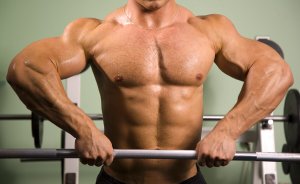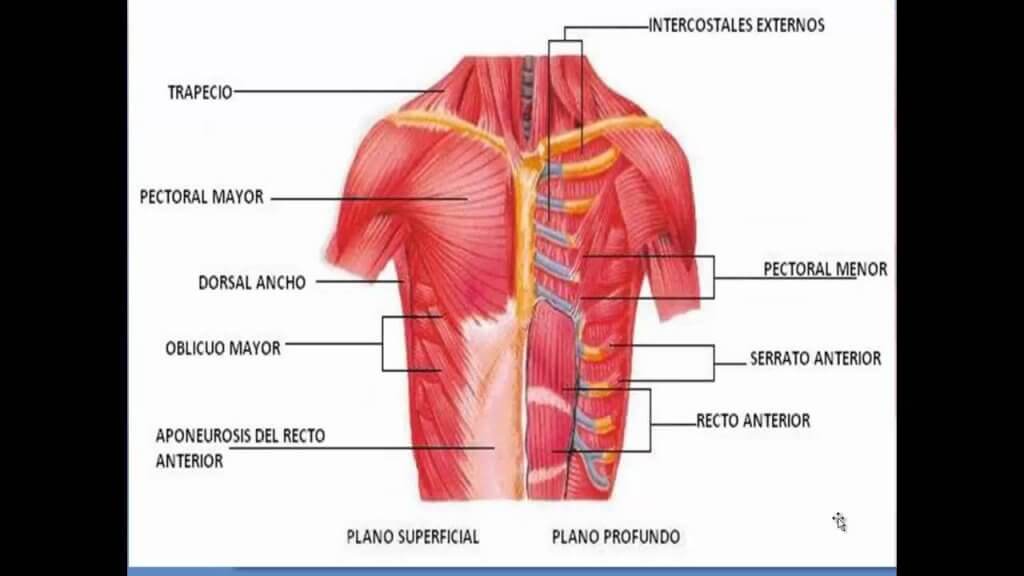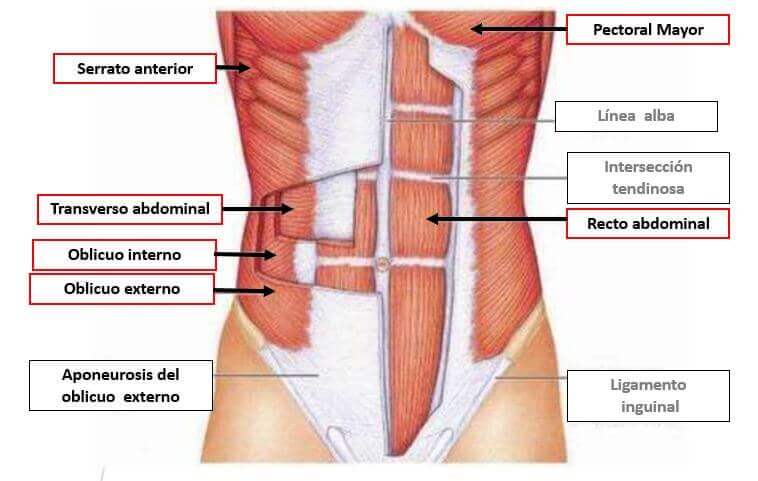Thorax and Abdomen Muscles

Muscles are structures that contract and relax to help us move. The whole body is covered in muscles. In today’s post, we want to focus on the thorax and abdomen muscles. Other than being essential for movement, they’re also crucial for maintaining posture and protecting internal organs as well.
Thorax muscles
The thorax covers the region that starts from the base of the neck leading to the diaphragm. It encompasses important organs such as the lungs, heart, and esophagus. The body also employs its skeletal system to protect these vital organs: the ribs and sternum.
The thoracic muscles are located just outside the ribs. In addition to playing an important role in our movements, they also protect the organs. Continue reading to learn about the most important muscles in this area and their functions.
Pectoralis major and minor: the best-known thorax muscles
The pectoralis major is a thick, flat muscle. It’s also the most important and strongest muscle in the anterior surface of the thorax. The muscle fibers stem from various areas: the clavicle, sternocostal joints and the costal cartilage in the abdominal region. This is inserted into the lateral lip of the bicipital groove of the humerus.
The pectoralis minor is thin and triangular-shaped. It’s smaller than the major and lies underneath it. It starts in the coracoid process of the shoulder blade and divides into three sections, which insert into the anterolateral surfaces of the third, fourth and fifth rib.
Serratus anterior: thorax
The serratus anterior is located on the border of the shoulder blade. It divides into three sections that insert into the anterolateral surfaces of the first ten ribs. The serratus anterior helps stabilize the body and also prepares other muscles for moving the upper limb away from the midline of the body.

The thorax: intercostal muscles
The external and internal intercostal muscles completely cover the intercostal spaces. Their sizes vary and each covers specific areas. However, generally speaking, they play an important role in respiration, especially during exercise.
Latissimus dorsi
The latissimus dorsi muscle is the biggest and most powerful muscle in the thorax region. In fact, it’s one of the strongest muscles in the entire human body. It attaches to all the vertebrae starting from the D7 vertebra and extends to the top of the sacrum and only consists of ascending muscle fibers.
The fibers insert into the intertubercular groove of the humerus. This muscle allows for abduction, internal rotation and extension movements for the homolateral upper limb.
Trapezius
The trapezius muscle is an important neck muscle but also extends down into the thorax region. To be exact, the lower portion of the trapezius muscle originates in the lower thoracic vertebrae. It inserts into the superior border of the scapula and allows it to rotate.
Abdominal muscles
The abdomen is the cavity that lies under the thorax. The diaphragm separates the two areas. Sitting above the pelvis, the abdomen houses many organs. Most of the organs belong to the digestive system such as the large and small intestines, stomach and liver. But, other organs, such as the kidneys, spleen, and pancreas are also nestled in this region.
The cavity needs a thick muscular layer to protect the organs in place. Should they bulge out of the cavity, hernias or protrusions can result as a consequence.
Anterolateral abdominal wall muscles
These muscles form concentric layers. From inside out, you’ll find the transverse and rectus abdominal muscles in the wall. Furthermore, the internal and external oblique muscles are located closer to the surface.

These muscles have many functions such as stabilizing the spine and compressing the organs, keeping them inside the abdominal cavity. Thus they contract and relax in processes such as urination, bowel movements, vomiting and even giving birth.
Furthermore, they also play an essential role in exhaling during physical activity. The famous washboard abs are a part of the rectus abdominal muscles and the lines that separate them down the middle are called the “white line”.
Posterior abdominal wall muscles
In the posterior wall you’ll find the lumbar triangle, which is formed by the thoracolumbar fascia. The muscle extends towards the latissimus dorsal muscle– take a moment to consider how large that is!
Tucked away in the inner section are the serratus posterior muscles, internal and external obliques– which stem from the anterolateral region–, and the quadratus lumborum. Adding on, the quadratus lumborum muscle covers the parietal peritoneum.
Wrapping up, this complicated structure forms our upper body. Learning about our muscles is no easy task– there are so many of them! But, the most important thing is to stay fit and active to keep your body healthy!
Muscles are structures that contract and relax to help us move. The whole body is covered in muscles. In today’s post, we want to focus on the thorax and abdomen muscles. Other than being essential for movement, they’re also crucial for maintaining posture and protecting internal organs as well.
Thorax muscles
The thorax covers the region that starts from the base of the neck leading to the diaphragm. It encompasses important organs such as the lungs, heart, and esophagus. The body also employs its skeletal system to protect these vital organs: the ribs and sternum.
The thoracic muscles are located just outside the ribs. In addition to playing an important role in our movements, they also protect the organs. Continue reading to learn about the most important muscles in this area and their functions.
Pectoralis major and minor: the best-known thorax muscles
The pectoralis major is a thick, flat muscle. It’s also the most important and strongest muscle in the anterior surface of the thorax. The muscle fibers stem from various areas: the clavicle, sternocostal joints and the costal cartilage in the abdominal region. This is inserted into the lateral lip of the bicipital groove of the humerus.
The pectoralis minor is thin and triangular-shaped. It’s smaller than the major and lies underneath it. It starts in the coracoid process of the shoulder blade and divides into three sections, which insert into the anterolateral surfaces of the third, fourth and fifth rib.
Serratus anterior: thorax
The serratus anterior is located on the border of the shoulder blade. It divides into three sections that insert into the anterolateral surfaces of the first ten ribs. The serratus anterior helps stabilize the body and also prepares other muscles for moving the upper limb away from the midline of the body.

The thorax: intercostal muscles
The external and internal intercostal muscles completely cover the intercostal spaces. Their sizes vary and each covers specific areas. However, generally speaking, they play an important role in respiration, especially during exercise.
Latissimus dorsi
The latissimus dorsi muscle is the biggest and most powerful muscle in the thorax region. In fact, it’s one of the strongest muscles in the entire human body. It attaches to all the vertebrae starting from the D7 vertebra and extends to the top of the sacrum and only consists of ascending muscle fibers.
The fibers insert into the intertubercular groove of the humerus. This muscle allows for abduction, internal rotation and extension movements for the homolateral upper limb.
Trapezius
The trapezius muscle is an important neck muscle but also extends down into the thorax region. To be exact, the lower portion of the trapezius muscle originates in the lower thoracic vertebrae. It inserts into the superior border of the scapula and allows it to rotate.
Abdominal muscles
The abdomen is the cavity that lies under the thorax. The diaphragm separates the two areas. Sitting above the pelvis, the abdomen houses many organs. Most of the organs belong to the digestive system such as the large and small intestines, stomach and liver. But, other organs, such as the kidneys, spleen, and pancreas are also nestled in this region.
The cavity needs a thick muscular layer to protect the organs in place. Should they bulge out of the cavity, hernias or protrusions can result as a consequence.
Anterolateral abdominal wall muscles
These muscles form concentric layers. From inside out, you’ll find the transverse and rectus abdominal muscles in the wall. Furthermore, the internal and external oblique muscles are located closer to the surface.

These muscles have many functions such as stabilizing the spine and compressing the organs, keeping them inside the abdominal cavity. Thus they contract and relax in processes such as urination, bowel movements, vomiting and even giving birth.
Furthermore, they also play an essential role in exhaling during physical activity. The famous washboard abs are a part of the rectus abdominal muscles and the lines that separate them down the middle are called the “white line”.
Posterior abdominal wall muscles
In the posterior wall you’ll find the lumbar triangle, which is formed by the thoracolumbar fascia. The muscle extends towards the latissimus dorsal muscle– take a moment to consider how large that is!
Tucked away in the inner section are the serratus posterior muscles, internal and external obliques– which stem from the anterolateral region–, and the quadratus lumborum. Adding on, the quadratus lumborum muscle covers the parietal peritoneum.
Wrapping up, this complicated structure forms our upper body. Learning about our muscles is no easy task– there are so many of them! But, the most important thing is to stay fit and active to keep your body healthy!
All cited sources were thoroughly reviewed by our team to ensure their quality, reliability, currency, and validity. The bibliography of this article was considered reliable and of academic or scientific accuracy.
- Anatomía Funcional. FCCAFD. Granada. [Internet]. [cited 2019 Jun 14]. Available from: https://www.ugr.es/~dlcruz/index.htm
- Tang A.; Bordoni B. Anatomy, Thorax, Muscles [Internet]. StatPearls. StatPearls Publishing; 2019 [cited 2019 Jun 14]. Available from: http://www.ncbi.nlm.nih.gov/pubmed/30855905
This text is provided for informational purposes only and does not replace consultation with a professional. If in doubt, consult your specialist.








